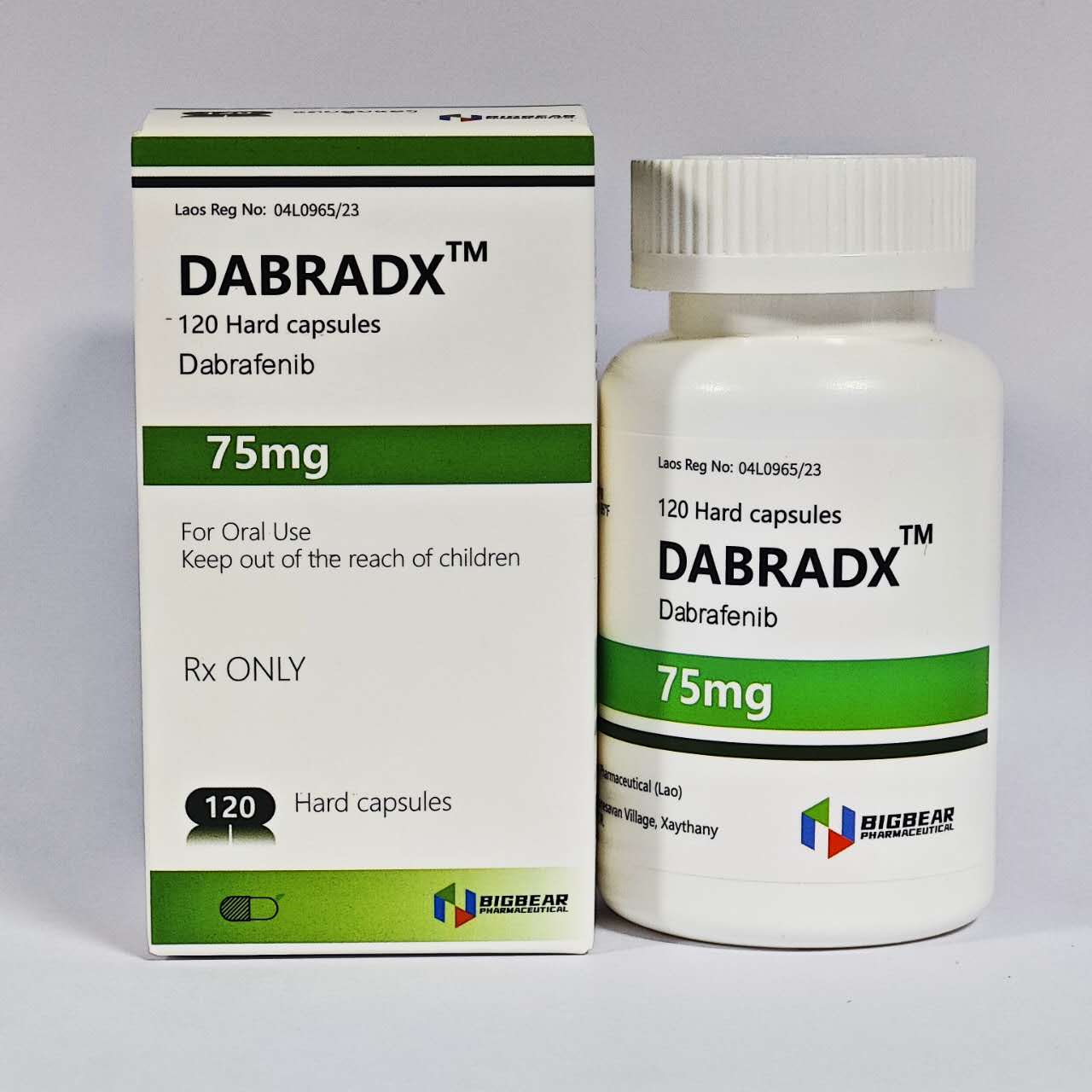DABRADX, Dabrafenib 75mg
Manufactor:Bigbear Pharmaceutical Laos
Introduction:Dabrafenib is a BRAF inhibitor cancer drug and is available in the form of mesylate. On May 29, 2013, the US Food and Drug Administration (FDA) simultaneously approved the marketing applications of dabrafenib and trametinib. Dabrafenib is approved for the treatment of unresectable melanoma (tumor that cannot be removed surgically) and metastatic melanoma (tumor that has spread to other organs in the body) with the BRAFV6Chemicalbook00E mutation, but not for wild-type BRAF mel...
chat onlinePhone: +8562052137046
Recommended
- details
【Drug Name】
Name: Dabrafenib capsules
Product Name: DABRADX
【Specification】
75mg
【Indications】
• alone or in combination with a medicine called trametinib to treat a type of skin cancer called melanoma:
o that has spread to other parts of the body or cannot be removed by surgery, and
o that has a certain type of abnormal “BRAF” gene.
• in combination with trametinib, to help prevent melanoma that has a certain type of abnormal “BRAF” gene from coming back after the cancer has been removed by surgery.
• in combination with trametinib to treat a type of lung cancer called non-small cell lung cancer (NSCLC):
o that has spread to other parts of the body, and
o that has a certain type of abnormal “BRAF” gene.
• in combination with trametinib to treat a type of thyroid cancer called anaplastic thyroid cancer (ATC):
o that has spread to other parts of the body and you have no satisfactory treatment options and
o that has a certain type of abnormal “BRAF” gene.
• in combination with trametinib to treat solid tumors in adults and children 6 years and older
o that cannot be removed with surgery or have spread to other parts of the body, and that have gotten worse (progressed) and you have no satisfactory treatment options, and
o that have a certain type of abnormal “BRAF” gene.
DABRADX is not for use in treating people with colorectal cancer or wild-type BRAF solid tumors.
Your healthcare provider will perform a test to make sure that DABRADX is right for you.
It is not known if DABRADX used in combination with trametinib is safe and effective in children younger than 6 years of age.
It is not known if DABRADX used alone is safe and effective in children.
【Recommended Dosage】
• Take DABRADX exactly as your healthcare provider tells you. Do not change your dose or stop DABRADX unless your healthcare provider tells you.
• Your healthcare provider may change your dose of DABRADX, temporarily stop, or completely stop your treatment with DABRADX if you develop certain side effects.
• Take DABRADX 2 times a day, about 12 hours apart.
• Take DABRADX at least 1 hour before or 2 hours after a meal.
• Do not open, crush, or break DABRADX capsules.
• If you miss a dose of DABRADX, take it as soon as you remember. If it is within 6 hours of your next scheduled dose, just take your next dose at your regular time. Do not make up for the missed dose.
【Side Effects】
• bleeding problems. DABRADX, when taken with trametinib, can cause serious bleeding problems, especially in your brain or stomach, that can lead to death. Call your healthcare provider and get medical help right away if you have any signs of bleeding, including:
o headaches, dizziness, or feeling weak
o cough up blood or blood clots
o vomit blood or your vomit looks like “coffee grounds”
o red or black stool that looks like tar
• heart problems, including heart failure. Your healthcare provider should check your heart function before and during treatment with DABRADX. Call your healthcare provider right away if you have any of the following signs and symptoms of a heart problem:
o feeling like your heart is pounding or racing
o shortness of breath
o swelling of your ankles or feet
o feeling lightheaded
• eye problems. DABRADX can cause severe eye problems that can lead to blindness. Call your healthcare provider right away if you get these symptoms of eye problems:
o blurred vision, loss of vision, or other vision changes
o see color dots
o halo (see blurred outline around objects)
o eye pain, swelling, or redness
• fever. Fever is common during treatment with DABRADX, but may also be serious. When taking DABRADX with trametinib, fever may happen more often or may be more severe. In some cases, chills or shaking chills, too much fluid loss (dehydration), low blood pressure, dizziness, or kidney problems may happen with the fever.
Call your healthcare provider right away if you get a fever during treatment with DABRADX.
Your healthcare provider may temporarily or permanently stop your treatment, or change your dose of DABRADX with trametinib if you have fevers. Your healthcare provider will treat you as needed for your fever and any signs and symptoms of infection, and should check your kidney function during and after you have had severe fever.
• serious skin reactions. Skin rash is a common side effect of DABRADX. DABRADX can also cause other skin reactions. In some cases, these rashes and other skin reactions can be severe or serious, and may need to be treated in a hospital or lead to death.
Tell your healthcare provider if you get a skin rash or acne that bothers you or worsens.
Tell your healthcare provider right away if you develop any of the following signs or symptoms of a severe skin reaction, including:
o blisters or peeling of your skin o blisters on your lips, or around your mouth or eyes
o mouth sores o high fever or flu-like symptoms
o enlarged lymph nodes
• increased blood sugar (hyperglycemia). Some people may develop high blood sugar or worsening diabetes during treatment with DABRADX. If you are diabetic, your healthcare provider should check your blood sugar levels closely during treatment with DABRADX. Your diabetes medicine may need to be changed. Tell your healthcare provider if you have any of the following symptoms of severe high blood sugar:
o increased thirst
o urinating more often than normal, or urinating an increased amount of urine
• DABRADX may cause healthy red blood cells to break down too early in people with G6PD deficiency. This may lead to a type of anemia called hemolytic anemia where the body does not have enough healthy red blood cells. Tell your healthcare provider if you have any of the following signs or symptoms:
o yellow skin (jaundice)
o weakness or dizziness
o shortness of breath
The most common side effects of DABRADX when taken alone include:
• thickening of the outer layers of the skin
• warts
• headache
• fever
• joint aches
• hair loss
• redness, swelling, peeling, or tenderness of hands or feet
The most common side effects of DABRADX when taken with trametinib in people with melanoma that has spread to other parts of the body or cannot be removed by surgery include:
• fever
• rash
• headache
• chills
• joint aches
• cough
The most common side effects of DABRADX when taken with trametinib to help prevent melanoma from coming back after the cancer has been removed by surgery include:
• fever
• tiredness
• nausea
• headache
• rash
• chills
• diarrhea
• vomiting
• joint aches
• muscle aches
The most common side effects of DABRADX when taken with trametinib in people with NSCLC include:
• fever
• tiredness
• nausea
• vomiting
• diarrhea
• dry skin
• decreased appetite
• rash
• swelling of face, arms, and legs
• chills
• bleeding
• cough
• shortness of breath
The most common side effects of DABRADX when taken with trametinib in adults with solid tumors that cannot be removed by surgery or have spread to other parts of the body include:
• fever
• bleeding
• tiredness
• cough
• nausea
• vomiting
• rash
• constipation
• chills
• diarrhea
• headache
• muscle and joint aches
• swelling of your arms and legs
The most common side effects of DABRADX when taken with trametinib in children with solid tumors that cannot be removed by surgery or have spread to other parts of the body include:
• fever
• acne
• rash
• headache
• vomiting
• stomach-area (abdomen) pain
• tiredness
• nausea
• dry skin
• bleeding
• cough
• constipation
• diarrhea
• skin infection around fingernails or toenails
DABRADX may cause fertility problems in females. This could affect your ability to become pregnant. Talk to your healthcare provider if this is a concern for you.
DABRADX may cause lower sperm counts in males. This could affect the ability to father a child. Talk to your healthcare provider if this is a concern for you.
These are not all of the possible side effects of DABRADX.
Call your doctor for medical advice about side effects
【Storage】
• Store DABRADX at room temperature between 68°F to 77°F (20°C to 25°C).
Keep DABRADX and all medicine out of the reach of children.

 中文
中文
